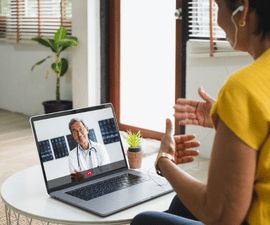
Treatment Planning
Telehealth

The utilization of technology to connect patients and healthcare providers remotely has significantly increased as a result of the COVID-19 pandemic. Telehealth, the remote method to receive healthcare, can encompass a wide range of technological modalities, including video visits, phone calls, and online communication.
Telehealth can be a valuable support to standard of care practices for patients with lymphoma. It provides a flexible platform for checkups and follow-up visits, where the patient’s doctor can monitor any existing comorbidities or new symptoms. It can also be used to get a second opinion with another specialist to confirm the patient’s diagnosis and evaluate if the course of treatment is the most appropriate based on the type of lymphoma. Patients should check with their insurance provider to ensure coverage before connecting and an out-of-state specialist via telehealth.
Insurance Concerns
The telehealth services available may have a cost, depending on the type of service provided. These costs may be covered by the patient’s health insurance. Before an appointment, patients should check with their insurance provide to learn about their options:
- Check with the doctor’s office to learn if telehealth service provided has a cost
- Review health insurance plan to learn what services are included and what may be out-of-pocket costs
- If covered under Medicaid, check directly with the state’s Medicaid office (coverage of telehealth services is different for each state)
- If covered under Medicare, visit the Medicare website to find a list of services covered for telehealth
- If not covered under health insurance, visit the Health & Human Services website to find local health centers that offer telehealth. Check with the doctor’s office to learn what services are offered and what the costs may be
Addressing Limited Access to Technology
While telehealth can help to overcome barriers to cancer care such as traveling, lack of paid sick leave and childcare needs, limited access to electronic devices (i.e. phones, tablets, computers), poor connectivity and low tech literacy can create new barriers.
Telehealth technology that requires several steps (download, registration and login) may be complicated for some patients. In addition, approximately one-quarter of American adults do not have broadband internet service at home, and socioeconomic factors also play a role in determining accessibility of broadband service at home. It is important for patients sto let their healthcare team know if they have limited access to internet or electronic resources. The healthcare team may be able to help with any barriers to utilizing telehealth.
Helpful Resources:
